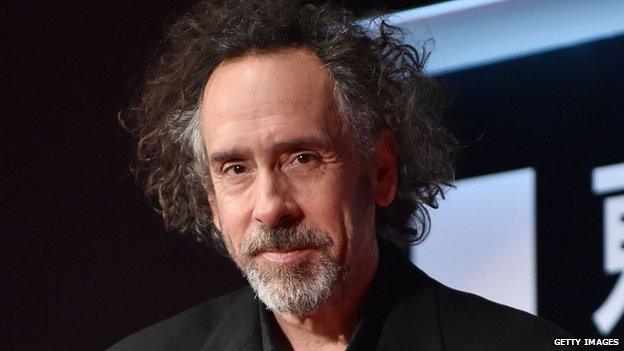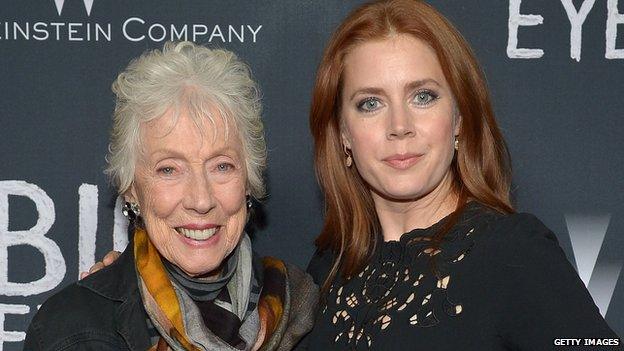Big Eyes: Tim Burton on art fraud that shocked America
- Published

Amy Adams as Margaret Keane in Big Eyes
Tim Burton's latest film tells the true story of a bizarre art fraud case in 1960s America.
Walter Keane's paintings of waifs with big tearful eyes were frowned on by art critics, but their huge popular success made him a fortune. Years later, the truth emerged: the works were actually not created by Walter, but by his wife Margaret - who painted them in secret while her husband took the credit.
Why did she go along with the deception? Would the paintings have become famous without the smooth-talking Walter to promote them?
These are questions that Burton explores in Big Eyes, which stars Amy Adams and Christoph Waltz as the Keanes, alongside Terence Stamp as New York art critic John Canaday who describes the artworks as "an infinity of kitsch".
The film reunites Burton with writers Scott Alexander and Larry Karaszewski, who worked with him on 1994 biopic Ed Wood, about the cult film-maker.
The director tells the BBC why he has long been fascinated by the weird-eyed portraits and how he copes with sharp-penned critics.


Tim Burton had commissioned paintings from Margaret Keane before he became involved in the film
How far back does your association with Keane paintings go?
Since childhood. I always thought of it as suburban art, because everyone had it. It was in people's living rooms, offices, doctors' offices, dentists' offices. You know that in childhood some things leave your memory, but these things stuck with me.
I'm interested in pop culture and things; it was just something that was very present and it wasn't until the mid-90s when a friend of mine in New York told me the story about the Keanes. Like most people, until that point I had thought that Walter was the painter of the work, because that's what I remember. I was like 'wow - this is an amazing, interesting story'.
When I was in San Francisco I visited Margaret [who still has a gallery there, external] and commissioned a painting from her. It was a couple of years later that I found out that Scott and Larry, who'd written Ed Wood, had a script based on the story.
Do you see an affinity between Margaret Keane and Ed Wood, who were both artists some people sneered at?
As much as people trashed the whole thing, there were a lot of people trying to copy it. I know a lot of people that are inspired by the 'big eye' thing. You have to admit that there's a reason why people had it in their living rooms. Even if you hate it, there's something there - it's like Ed Wood, he's the worst film-maker in the world but at the same time there was a weird poetry to his films and you could remember them over other films that won Academy Awards.
That question of what's good and bad is something that I've always been interested in, because I've experienced it myself. I do identify with those kind of characters, because there's two sides to the story.

THE KEANES

Amy Adams and Christoph Waltz play the Keanes in Big Eyes
Margaret met Walter in 1955 at an outdoor art exhibition in San Francisco.
They married the same year and divorced in 1965.
In 1970, having moved to Hawaii, Margaret told a journalist the truth about the paintings.
She sued Walter and in court the judge challenged them both to paint a child with big eyes.
Walter claimed he couldn't paint because he had a sore shoulder.
Walter died in 2000, several years before the Big Eyes screenplay began to take shape.
Margaret is now aged 87 and lives just outside San Francisco.
She continues to paint almost daily.
Modigliani is one of her favourite artists.
Some 300 paintings, and hundreds of sketches, were made for the film over two months.
Margaret has a cameo as a little old lady sitting on a park bench.

It's a lower budget film, with very few special effects, in contrast to your past work. Did that make it more personal for you?
After doing lots of big studio stuff, it was nice to strip back, have a low budget, and have to move quickly. That reconnects you with why you like making movies on a certain level. You don't hear the term franchise, you don't hear about the McDonalds tie-in, so it's quite nice to not have that kind of spectre hanging over you.
In the film John Canaday, the art critic, says Mr Keane "is why society needs critics to protect them from such atrocities". What's your relationship been like with critics throughout your career?
From the beginning of my career, films like Pee-wee's Big Adventure or Beetlejuice were in the top 10 worst films of the year. I've had that Batman's too dark, and this and that... or some people like it.
I feel lucky because I know people who make a film and it gets some great reviews, and then they're only in for a fall.
I feel like I've been sort of well-balanced. I had movies being horribly reviewed that do very well, and movies that are reviewed very well but do horribly at the box office.
My MoMA [Museum of Modern Art] show in New York recently got almost completely panned - probably worse than Keane. At the same time we had the highest attendance ratings. So you get a mixture of things, in a bizarre way it balances you out.

Artist Margaret Keane (left) met actress Amy Adams, who plays her in Big Eyes, and also has a cameo role in the film
Do you find at this stage of your career that you deal with criticism better than you did?
I don't really read it too much. I actually have trouble looking at anything, even positive ones, or negative, I know enough - people tell me, so I'm not living in a dream world.
Your next film is Miss Peregrine's Home for Peculiar Children - with Hugo star Asa Butterfield in the cast. What's your vision for the film?
Hugo doesn't seem like it was that long ago... [Asa] has obviously become a young adult, but he's still got an incredible presence, and I'm really looking forward to working with him.
When I read Miss Peregrine's Home for Peculiar Children, there was a vibe about it that felt different. I think that's the key, to try to capture the spirit of the book. That's why I'm casting peculiar people.
Big Eyes is out in the UK on Friday 26 December.